 Java
Java
 javaTutorial
javaTutorial
 What is the difference between using foreach and iterator to delete elements when traversing Java ArrayList?
What is the difference between using foreach and iterator to delete elements when traversing Java ArrayList?
What is the difference between using foreach and iterator to delete elements when traversing Java ArrayList?
1. The difference between Iterator and foreach
Polymorphic difference (the bottom layer of foreach is Iterator)
Iterator is an interface type, it does not care about the type of the collection or array;
Both for and foreach need to know the type of the collection first, even the type of the elements in the collection ;
1. Why is it said that the bottom layer of foreach is the code written by Iterator
:
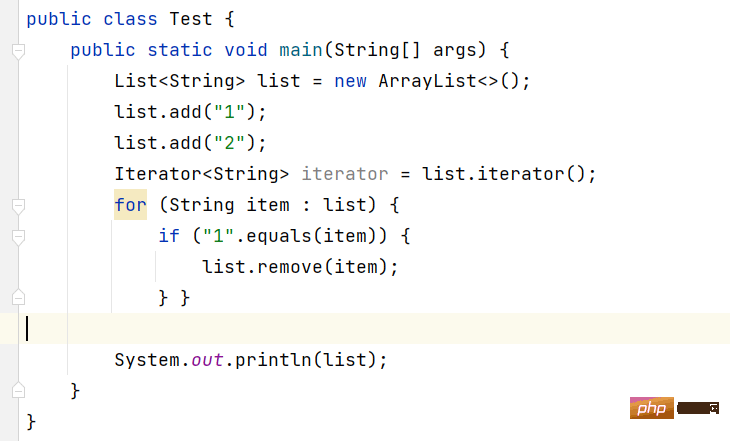
##Decompiled code:
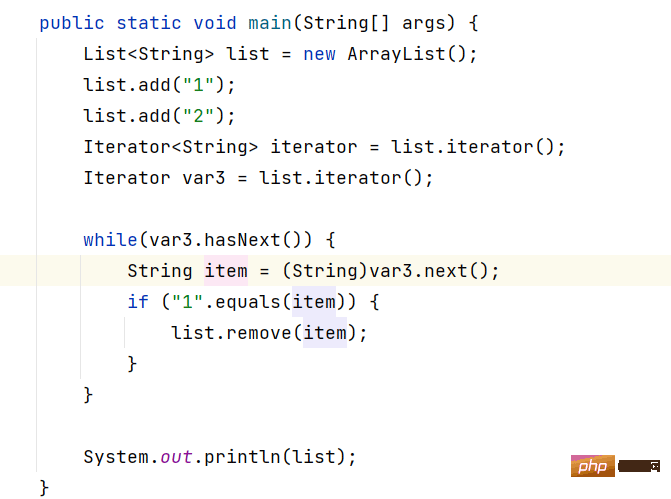
But no error will be reported in time 1, and an error will be reported in time 2 (java.util.ConcurrentModificationException)
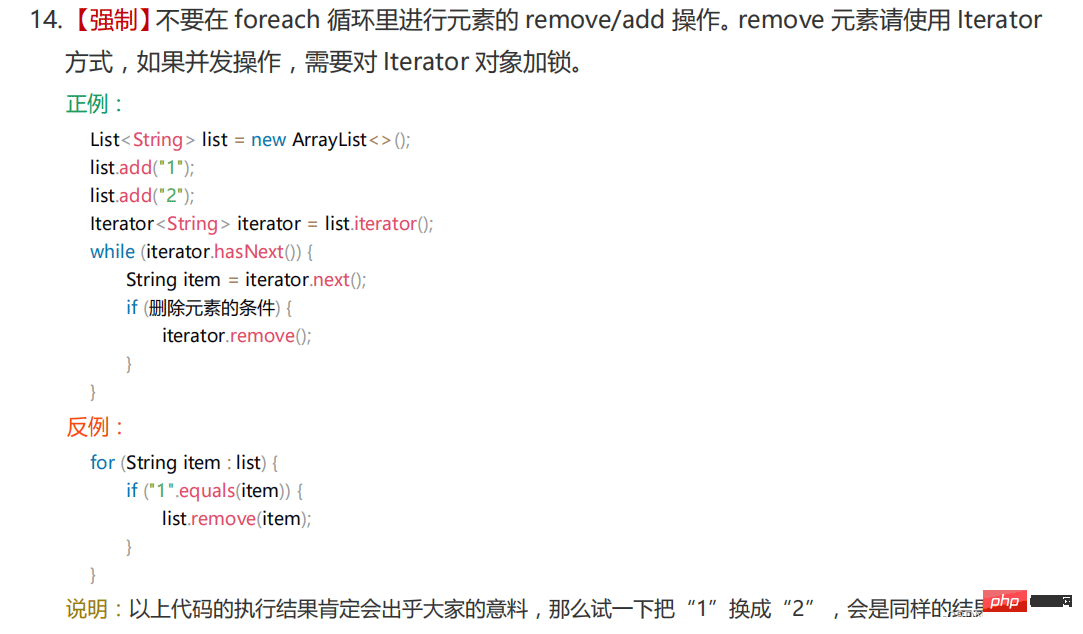
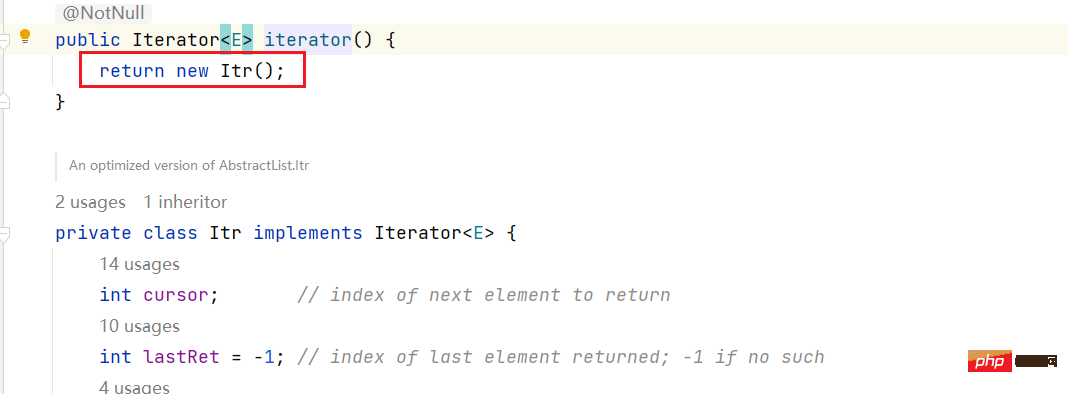 calls new Itr() to generate the Itr class (iterator). At this time, the three parameters of Itr will be initialized.
calls new Itr() to generate the Itr class (iterator). At this time, the three parameters of Itr will be initialized.
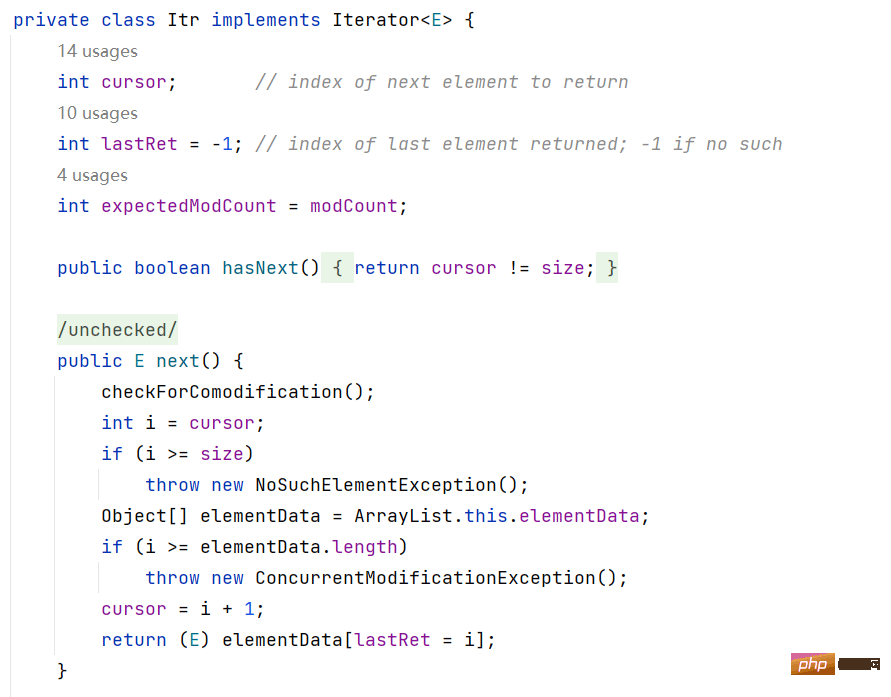
- cursor represents the next index position (starting at 0)
- size is the size of the collection (2)
When next method (), checkForComodification will be checked for equality
 modCount modification count (each add and remove will be 1) expectedModCount expected maximum count
modCount modification count (each add and remove will be 1) expectedModCount expected maximum count
1.remove operation source code analysis
First let’s take a look at deleting “2” Situation:First loop:
Because the modCount and expectedModCount at this time are both 2 (modCount is 2 because it was added twice), so no exception will be thrown in the first loop , exceptions are thrown when it is not the first time in the loop. After the next method is completed, the if condition of the remove method in the foreach loop method body is not satisfied, and the loop ends.
Second loop:
The hasNext and next methods of the second loop can be completed successfully. After that, it will enter the remove method in the foreach loop method body. To delete elements. At this time, size-1 becomes 1. In the fastRemove method in the remove method, modCount is set to 1, which becomes 3.
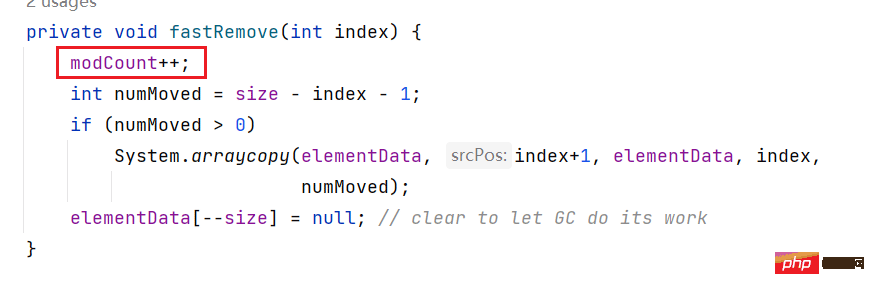
Then it will go to the hasNext method in the third loop. Under normal circumstances, this method will return false, but because the size at this time has changed to 1, and the cursor at this time is 2 (cursor represents the next index position), so the two are not equal, and an error is returned. true, so it will continue to go to the checkForComodification method in the next method to determine whether the modCount and expectedModCount at this time are equal. Because the modCount at this time has changed to 3, which is different from the expectedModCount value of 2, a ConcurrentModificationException exception was thrown here.
Let’s take a look at why no exception is thrown when deleting “1”:
Same as above, the modCount and expectedModCount at this time are both 2, so the hasNext and next methods in the first loop will not throw an exception. After this, you will enter the remove method in the foreach loop method body to delete the element. Same as above, size-1 becomes 1, and modCount 1 becomes 3.
The second loop:In the hasNext method of the second loop, the cursor at this time is 1, and the size is also 1, and they are equal. Therefore, when the hasNext method returns false, it will jump out of the foreach loop and will not go to the subsequent next method, so it will not throw an exception.
2. Source code steps
The first timeThe first sentence calls iterator(),
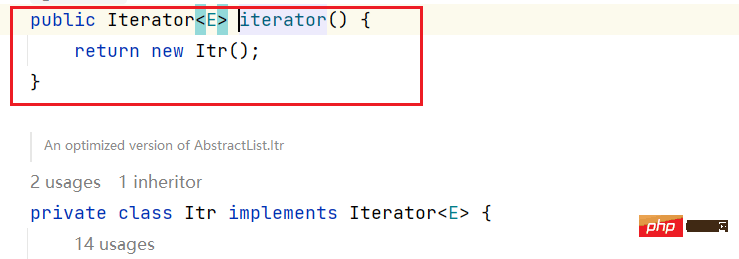 Call new Itr() to generate the Itr class (iterator). At this time, the three parameters of Itr will be initialized.
Call new Itr() to generate the Itr class (iterator). At this time, the three parameters of Itr will be initialized.
At this time expectedModCount == modCount == 2 (because the list mobilizes the add method, the add method will implement the operation on modCount)
The second sentence calls the hasNext() method below to return the subscript of the next element to be accessed. cursor, because it is the first loop, so the cursor is 0 and the size is 2 (0 != 2 true)
The next() method is called in the third sentence, and the if condition of the remove method in the foreach loop method body is not satisfied. , this ends the cycle
The second time
The second sentence calls the hasNext() method below and returns the subscript cursor of the next element to be accessed. Second loop, so the cursor is 1,
size is still 2 (1 != 2 true)
The third sentence calls the next() method, takes the value normally, and gets the first element "2";
Sentence ④ calls the remove() method and successfully deletes elements from the list. Note that when calling the remove method, there is modCount. All at this time, modCount3, expectedModCount2, size1
The third time
The second sentence calls the hasNext() method below and returns the subscript cursor of the next element to be accessed. , the second loop, so the cursor is 2 and the size is 1
The third sentence calls the next() method. Note that the first sentence in the next() method is to call checkForComodification(); due to modCount(3)! = expectedModCount(2), so an exception was thrown.
3. Why is iterator the bottom layer, why does foreach report an error

When the loop ends, while (iterator.hasNext() ) will check whether the next element exists. After remove delete 2 is completed, the next time you enter the cursor is still 1, and the size is also 1.
Foreach, after removing remove2, the next time you enter the cursor is 2, and the size is 1, so To return false, go to the next method, and then check, modCount=3, and expectedModCount=2
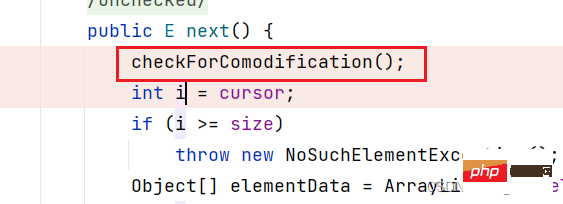

3. View the source code method
If you view the ArrayList under iterator

The above is the detailed content of What is the difference between using foreach and iterator to delete elements when traversing Java ArrayList?. For more information, please follow other related articles on the PHP Chinese website!

Hot AI Tools

Undresser.AI Undress
AI-powered app for creating realistic nude photos

AI Clothes Remover
Online AI tool for removing clothes from photos.

Undress AI Tool
Undress images for free

Clothoff.io
AI clothes remover

AI Hentai Generator
Generate AI Hentai for free.

Hot Article

Hot Tools

Notepad++7.3.1
Easy-to-use and free code editor

SublimeText3 Chinese version
Chinese version, very easy to use

Zend Studio 13.0.1
Powerful PHP integrated development environment

Dreamweaver CS6
Visual web development tools

SublimeText3 Mac version
God-level code editing software (SublimeText3)

Hot Topics
 1378
1378
 52
52
 Perfect Number in Java
Aug 30, 2024 pm 04:28 PM
Perfect Number in Java
Aug 30, 2024 pm 04:28 PM
Guide to Perfect Number in Java. Here we discuss the Definition, How to check Perfect number in Java?, examples with code implementation.
 Random Number Generator in Java
Aug 30, 2024 pm 04:27 PM
Random Number Generator in Java
Aug 30, 2024 pm 04:27 PM
Guide to Random Number Generator in Java. Here we discuss Functions in Java with examples and two different Generators with ther examples.
 Weka in Java
Aug 30, 2024 pm 04:28 PM
Weka in Java
Aug 30, 2024 pm 04:28 PM
Guide to Weka in Java. Here we discuss the Introduction, how to use weka java, the type of platform, and advantages with examples.
 Smith Number in Java
Aug 30, 2024 pm 04:28 PM
Smith Number in Java
Aug 30, 2024 pm 04:28 PM
Guide to Smith Number in Java. Here we discuss the Definition, How to check smith number in Java? example with code implementation.
 Java Spring Interview Questions
Aug 30, 2024 pm 04:29 PM
Java Spring Interview Questions
Aug 30, 2024 pm 04:29 PM
In this article, we have kept the most asked Java Spring Interview Questions with their detailed answers. So that you can crack the interview.
 Break or return from Java 8 stream forEach?
Feb 07, 2025 pm 12:09 PM
Break or return from Java 8 stream forEach?
Feb 07, 2025 pm 12:09 PM
Java 8 introduces the Stream API, providing a powerful and expressive way to process data collections. However, a common question when using Stream is: How to break or return from a forEach operation? Traditional loops allow for early interruption or return, but Stream's forEach method does not directly support this method. This article will explain the reasons and explore alternative methods for implementing premature termination in Stream processing systems. Further reading: Java Stream API improvements Understand Stream forEach The forEach method is a terminal operation that performs one operation on each element in the Stream. Its design intention is
 TimeStamp to Date in Java
Aug 30, 2024 pm 04:28 PM
TimeStamp to Date in Java
Aug 30, 2024 pm 04:28 PM
Guide to TimeStamp to Date in Java. Here we also discuss the introduction and how to convert timestamp to date in java along with examples.
 Java Program to Find the Volume of Capsule
Feb 07, 2025 am 11:37 AM
Java Program to Find the Volume of Capsule
Feb 07, 2025 am 11:37 AM
Capsules are three-dimensional geometric figures, composed of a cylinder and a hemisphere at both ends. The volume of the capsule can be calculated by adding the volume of the cylinder and the volume of the hemisphere at both ends. This tutorial will discuss how to calculate the volume of a given capsule in Java using different methods. Capsule volume formula The formula for capsule volume is as follows: Capsule volume = Cylindrical volume Volume Two hemisphere volume in, r: The radius of the hemisphere. h: The height of the cylinder (excluding the hemisphere). Example 1 enter Radius = 5 units Height = 10 units Output Volume = 1570.8 cubic units explain Calculate volume using formula: Volume = π × r2 × h (4



